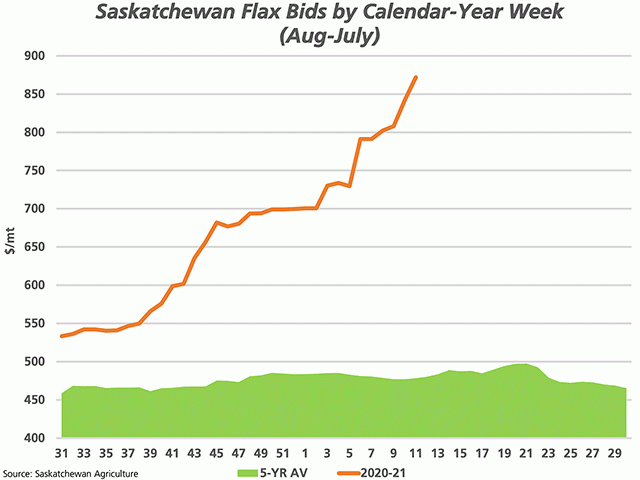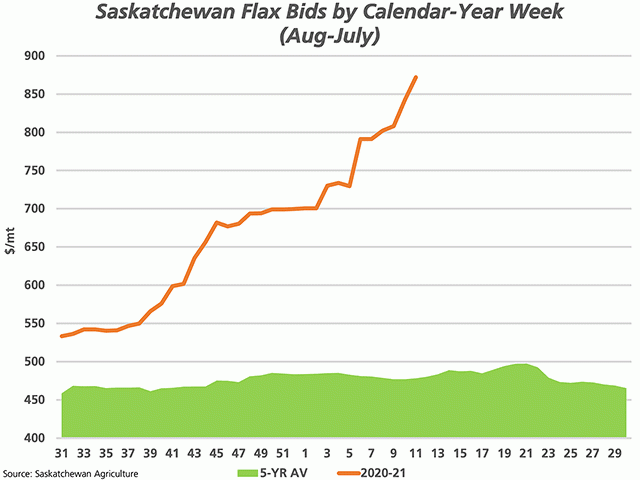Canada Markets
Prairie Flax Bids on Fire
Saskatchewan Agriculture's weekly Market Trends shows the average flax price delivered to Saskatchewan elevators rose by $29.53 metric ton (mt) from the previous week to $871.89/mt ($22.14/bushel). One broker report indicates prices ranging from $21 busehl (bu) to $23/bu FOB farm. Saskatchewan Agriculture data going back to 1982 shows current prices by far the highest reached, taking out a 2013 high of $681.92/mt reached in April and the 2008 weekly high of $762.77/mt reached in July.
Despite the largest production achieved in four years of 578,000 mt, demand for flax and global demand for vegetable oils in general has been a supportive feature for this market. In December, AAFC increased their export forecast for flax by 50,000 mt to 500,000 mt, while boosting this volume further by 40,000 mt in February to 540,000 mt. This would be the largest exports achieved in five years and are forecast to shrink ending stocks to 50,000 mt, the tightest stocks since the 2004-05 crop year representing 8.2% of total disappearance.
P[L1] D[0x0] M[300x250] OOP[F] ADUNIT[] T[]
As of week 31, the Canadian Grain Commission reports exports through licensed facilities at 216,800 mt, up 114.9% from the same period in 2019-20 and 34.3% higher than the five-year average. What is interesting is that when the seasonality of flax shipments is considered, over the past five years, an average of only 34.3% of total crop-year exports are reported as of the CGC's week 31 report, which represents the first 60% of the crop year. Recent history would point to exports concentrated in the final months of the crop year. In the 2019-20 crop year, only 29% of total exports were shipped in the first 31 weeks of the crop year.
Projecting this historical pace forward, the potential for Canadian exports this crop year surpasses available supplies given current supply estimates. In the first six months of the crop year (Aug-Jan), Statistics Canada reports 191,700 mt of exports, of which 34,200 mt or 17.8% of the total was shipped to China, down sharply from previous crop years. CGC data over the past five years shows an average of 52% of crop-year exports of flax were destined for China, while 38% of exports were shipped to China in 2019-20.
As of week 31, producers have delivered 353,300 mt into the licensed handling system, up 164,000 mt from this period in 2019-20, while 88,320 mt higher than the three-year average. Given Statistics Canada's estimate of farm stocks as of July 31, 2020, added to estimated 2020 production, producers have delivered 58.6% of available supplies, up from the five-year average of 37% as of week 31.
The risk to sellers holding unpriced product is that supplies tighten to the point where buyers shift interest to new-crop and avoid the risk of owning old-crop at current levels. This should be viewed as a great time to be sold on old crop while considering new-crop pricing. AAFC is currently forecasting a 22% increase in flax acres seeded in 2021 to 1.137 million acres, which would be the highest acres seeded in six years, although this area could be expanded further.
Cliff Jamieson can be reached at cliff.jamieson@dtn.com
Follow him on Twitter @Cliff Jamieson
(c) Copyright 2021 DTN, LLC. All rights reserved.






Comments
To comment, please Log In or Join our Community .